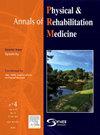关节内注射肉毒毒素治疗关节疼痛的有效性和安全性:系统回顾和荟萃分析。
IF 4.6
3区 医学
Q1 REHABILITATION
Annals of Physical and Rehabilitation Medicine
Pub Date : 2025-02-01
DOI:10.1016/j.rehab.2024.101877
引用次数: 0
摘要
背景:在各种关节疼痛动物模型中进行的研究表明,关节内A型肉毒毒素(BoNT-A)具有抗伤害性作用。在人体中进行的随机对照试验(RCTs)显示了潜在的影响,但结果却截然不同。目的:评价关节内BoNT-A治疗关节疼痛的疗效和安全性。方法:我们对随机对照试验进行了系统回顾,比较了关节内BoNT-A与其他干预措施在短期(6个月)内对关节疼痛患者疼痛和活动限制的影响及其不良反应。我们在适当的时候进行了荟萃分析。检索了MEDLINE、EMBASE、ClinicalTrials.gov、CINHAL和ICTRP数据库,检索时间为2023年7月9日。两名独立的审稿人选择了符合条件的研究,并以标准化的方式提取数据。定量合成结果用标准化平均差(SMD)(95%置信区间)表示。结果:我们纳入了14项随机对照试验:437名参与者接受关节内注射BoNT-A, 551名参与者接受另一种干预。总体而言,7项随机对照试验(549名参与者)比较了关节内BoNT-A与膝关节关节内治疗:疼痛的短期、中期和长期SMD分别为-0.35(-0.82至0.12)、-0.27(-0.61至0.08)和-0.43(-1.12至0.26),活动受限的SMD分别为-0.44(-0.96至0.07)、-0.24(-0.63至0.15)和-0.42(-1.26至0.42)。两项肩部随机对照试验(68名受试者)和一项拇指基底随机对照试验(60名受试者)显示短期疼痛减轻。轻微不良事件并不罕见,但没有报道与关节内BoNT-A相关的严重不良事件。结论:关节内BoNT-A可以在短期内减轻中小型关节(如拇指底和肩部)的关节疼痛,但对于大型关节(如膝关节)则没有效果。注册:PROSPERO: CRD42021290157(首次提交日期:2021年11月8日;注册日期:2021年12月8日)。本文章由计算机程序翻译,如有差异,请以英文原文为准。
Efficacy and safety of intra-articular botulinum toxin injection therapy for joint pain: A systematic review and meta-analysis
Background
Studies conducted in various animal models of joint pain showed an anti-nociceptive effect of intra-articular botulinum toxin type A (BoNT-A). Randomized controlled trials (RCTs) in humans suggest a potential effect but results are disparate.
Objectives
To assess the efficacy and safety of intra-articular BoNT-A for the treatment of joint pain.
Methods
We conducted a systematic review of RCTs comparing the effects of intra-articular BoNT-A to other interventions on pain and activity limitations in the short (<3 months), intermediate (3–6 months) and long term (> 6 months), and their adverse effects, in people with joint pain. We performed a meta-analysis when appropriate. MEDLINE, EMBASE, ClinicalTrials.gov, CINHAL and ICTRP databases were searched from inception to July 9, 2023. Two independent reviewers selected eligible studies and extracted data in a standardized manner. The results of quantitative synthesis were expressed as the standardized mean difference (SMD) (95 % confidence interval).
Results
We included 14 RCTs: 437 participants received an intra-articular injection of BoNT-A and 551 received another intervention. Overall, 7 RCTs (549 participants) compared intra-articular BoNT-A with an intra-articular treatment in the knee: short-, intermediate-, and long-term SMD were -0.35 (-0.82 to 0.12), -0.27 (-0.61 to 0.08), and -0.43 (-1.12 to 0.26) for pain and -0.44 (-0.96 to 0.07), -0.24 (-0.63 to 0.15) and -0.42 (-1.26 to 0.42) for activity limitations, respectively. Two RCTs (68 participants) in the shoulder and 1 RCT (60 participants) in the base-of-thumb showed reduced pain in the short term. Minor adverse events were not rare, but no serious adverse events related to intra-articular BoNT-A were reported.
Conclusions
Intra-articular BoNT-A may reduce joint pain in the short term for small and medium-sized joints (ie, base-of-thumb and shoulder), but not for large joints (ie, knee).
Registration
PROSPERO: CRD42021290157 (Date of first submission: 8 November 2021; Date of registration: 8 December 2021).
求助全文
通过发布文献求助,成功后即可免费获取论文全文。
去求助
来源期刊

Annals of Physical and Rehabilitation Medicine
Medicine-Rehabilitation
CiteScore
7.80
自引率
4.30%
发文量
136
审稿时长
34 days
期刊介绍:
Annals of Physical and Rehabilitation Medicine covers all areas of Rehabilitation and Physical Medicine; such as: methods of evaluation of motor, sensory, cognitive and visceral impairments; acute and chronic musculoskeletal disorders and pain; disabilities in adult and children ; processes of rehabilitation in orthopaedic, rhumatological, neurological, cardiovascular, pulmonary and urological diseases.
 求助内容:
求助内容: 应助结果提醒方式:
应助结果提醒方式:


